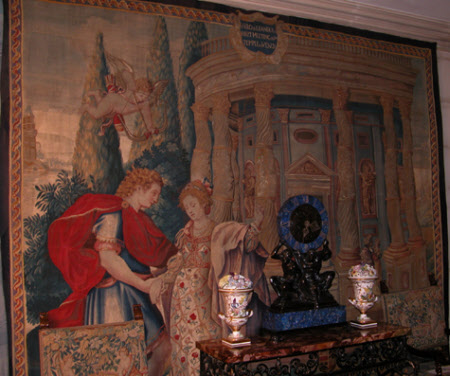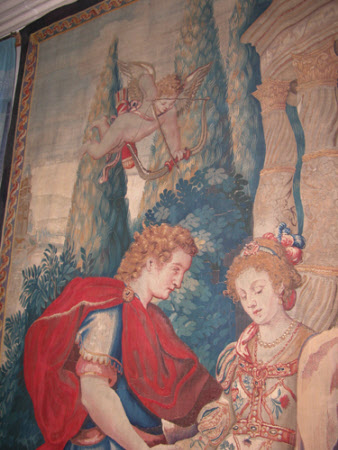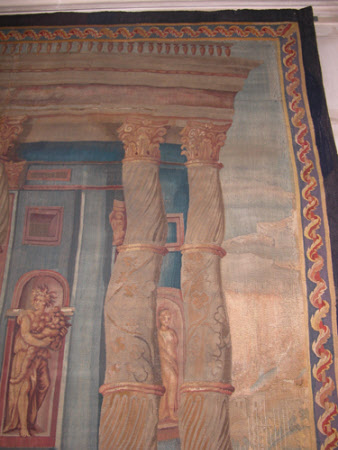The Meeting of Hero and Leander
English
Category
Tapestries
Date
circa 1670 - circa 1700
Materials
Tapestry, wool and silk, 7 warps per cm
Measurements
3.03 m (H); 3.38 m (W)
Place of origin
England
Order this imageCollection
Anglesey Abbey, Cambridgeshire
NT 516796
Summary
Tapestry, wool and silk, 7 warps per cm, The Meeting of Hero and Leander, English, probably Mortlake, c. 1670-1700. In the foreground are the young couple Hero and Leander. Leander takes Hero’s hand and looks into her eyes while she looks shyly down at the ground and points upwards with her left hand. Leander wears a blue tunic and a fluttering red cloak, and Hero wears a white dress embroidered with a golden lattice and colourful flowers, and carries a cloak over her arm. Above the couple a small figure of cupid hovers in the air, nude save for his quiver of arrows, aiming his bow at Hero’s heart. Behind the couple to the right is the Temple of Venus, a circular building surrounded by twisted Solomonic columns. On the walls of the building are golden statues of Bacchus, with a bunch of grapes, and Ceres, with a cornucopia, and inside the temple is a statue of Venus, approached by worshippers who climb the steps of the temple in pairs. Directly behind the pair of lovers are bushes and a row of cypress trees, and beyond this the sea with Hero's tower on the far shore. The tapestry has a narrow border with twisted red acanthus leaves on a blue ground.
Full description
'The Meeting of Hero and Leander' comes from a larger series of 'The Story of Hero and Leander', first woven at Mortlake in the late 1620s. The story of Hero and Leander was told by the 6th-century poet Musaeus Grammaticus, whose verse was been based on an earlier and now lost original. The source for the tapestry series was a poem written by Christopher Marlowe, based on the first half of Musaeus’s story and extended by George Chapman to complete the narrative. Marlowe and Chapman's joint work was first published in 1598 and reappeared in many subsequent editions. The young lovers Hero and Leander lived on opposite sides of the Hellespont (the Dardanelles), Leander at Abydos on the Asian side and Hero at Sestos on the European side, where she was a priestess at a Temple devoted to the Goddess Aphrodite (Venus). It was at the Temple of Venus at Sestos that the lovers first met and fell in love, and this is the subject of the tapestry at Anglesey Abbey, the first in the series. The occasion was a festival of Love devoted to Venus, and the visiting crowds can be seen ascending the steps of the temple in the background of the tapestry. Leander was one of the visitors, and as soon as he saw Hero Cupid’s arrow flew and he fell in love instantly. Initially the two “parled by touch of hands” (Marlowe, 'Hero and Leander', line 185). Hero’s demure downward look, and her gesture with her left hand, pointing upwards to the heavens, demonstrate her initial resistance to Leander's advances and her protestations of devotion to the service of Venus. Hero soon relented and allowed Leander to come back to her tower on the sea shore at Sestos. Henceforth every night Leander would swim across the Hellespont, the sea that separated Sestos and Abydos, to see her. One night however there was a terrible storm which extinguished the light that Hero kept burning to guide him. Leander was crushed by the waves and his dead body washed up on the shore by Hero's tower the next morning. Hero was so distraught that she died of grief. Some elements in the design of 'The Meeting of Hero and Leander' seem to foreshadow the tragic end to the story, including the myrtle bush, sacred to Cupid, and the row of cypress trees, associated with death and mourning. The 'Hero and Leander' series was designed by Francis Cleyn (1582 – 1658), a German artist who arrived in England in 1625 to work for Charles I and became designer to the Mortlake tapestry workshop. The 'Hero and Leander' series was one of Cleyn's first designs for Mortlake, and was completed by 1630 when the first set of tapestries was paid for by Charles I. At least three sets of 'Hero and Leander' were woven for the king in the late 1620s and 1630s, and at least two were given as diplomatic gifts (Hefford 2007, pp. 190-195). ‘Hero and Leander’ tapestries continued to be woven until the civil war, and a set of six cartoons for the series appeared in the Commonwealth Inventory in 1651 (Millar 1972, p. 623). On the basis of its quality, which is not as fine or detailed as the early Mortlake weavings, and also the simple borders, the tapestry at Angelsey Abbey can be dated to c. 1670-1700. The tapestry could have been woven at Mortlake, which continued to use many of the old Charles I-era designs until it closed in 1703. But by this time a number of other workshops had sprung up in the London area, many of them manned by ex-Mortlake weavers. These smaller workshops also wove versions of Mortlake designs, including 'Hero and Leander' (see for example Finch 1907), making it difficult to firmly attribute English tapestries of this period. A series of letters written in 1670 by Sir Sackville Crow, who had been Director at Mortlake from 1662-67 but was now in the Debtor’s Prison of the Fleet, reveals the continued popularity of the ‘Hero and Leander’ series. Asked by the Countess of Rutland to advise her on commissioning a set of tapestries, he noted that ‘Hero and Leander’ was one of only six designs in England worth weaving, and warned that “[From] whomsoever I doubt you will hardly get Hero made under 25s. per ell, to be well done”, mentioning two other workshops that could weave the tapestries but advising the Countess that it was worth paying more to have them woven at Mortlake, as the quality would be far higher (quoted in Thomson 1973, pp. 302-3). 'Hero and Leander' was by far the most popular English tapestry series of the seventeenth century. Parts of two sets of 'Hero and Leander' woven in the early 1630s survive, one in the Swedish Royal Collection (Böttiger 1895-98, vol. III, suite Lit. P, pp. 30-31), and one at Lyme Park, Cheshire, with one panel from the set at the V&A (no. 500301; Mulherron and Wyld 2011). Both these sets are woven with large amounts of gold thread in elaborate borders designed by Cleyn. At Hardwick Hall there is a set of five panels which may date from the 1640s or 1650s (no. 1129507). A set of four panels in the Primatial Palace, Bratislava may be of similar date. By far the largest number of surviving series date from the period c. 1660-1700. These include sets in the Lady Lever Art Gallery, Port Sunlight, the Bowes Museum, Cotehele House, Cornwall (no. 348324), as well as numerous partial sets that have passed through the English collections and sale rooms during the twentieth century (see for example Marillier 1930, pp. 49-51). This tapestry and another now at Anglesey Abbey, 'The Kindness of Rebecca' (no. 516751) were sent to Lord Fairhaven's mother, Cara Leyland Broughton, on approval in 1922. The present tapestry was described as "A 17th.Cent. Mortlake panel, 'Hero and Leander Meeting in the Temple of Venus'" and priced at £700. The letter accompanying the tapestries promised a 10% discount if cash was paid and if both tapestries were bought (copy of letter held at Anglesey Abbey). (Helen Wyld, 2011)
Provenance
Bequeathed to the National Trust by Huttleston Rogers Broughton, 1st Lord Fairhaven (1896-1966) with the house and the rest of the contents.
Credit line
Anglesey Abbey, The Fairhaven Collection (The National Trust)
Marks and inscriptions
In cartouche in upper border:: HERO & LEANDERS / FIRST MEETING IN YE / TEMPLE OF VENUS
Makers and roles
English, workshop probably Mortlake Tapestry Manufactory , workshop Francis Clein [also Cleyn] (Rostock 1582 – London 1658), designer
References
Mulherron and Wyld, 2011: Jamie Mulherron and Helen Wyld, 'Mortlake's Big Swim', National Trust Historic Houses and Collections Annual, June 2010, pp. 20-29 Hefford, 2007: Wendy Hefford, ‘The Mortlake Manufactory, 1619-49’, in Thomas Campbell (ed.), Tapestry in the Baroque: Threads of Splendor, exh. cat. Metropolitan Museum of Art, New York 2007, pp. 171-89 Cheney and Striar, 2006: Patrick Cheney and Brian J Striar, The Collected Poems of Christopher Marlowe, Oxford and New York 2006 Campbell, 1987: Thomas Campbell, A Consideration of the Career and Work of Francis Clein, unpublished MA Thesis, Courtauld Institute of Art, University of London, 1987 Sasky, 1978: Ladislav Sasky, ‘In View: Bratislava Tapestries’, Art and Artists, vol. XIII, no. 7 (November 1978), p. 57 Thomson, 1973: W G Thomson, A History of Tapestry from the Earliest Times until the Present Day, 3rd edition, Wakefield 1973 Millar, 1972: Oliver Millar (ed.), ‘The Inventories and Valuations of the King’s Goods 1649-1651’, The Forty-Third Volume of the Walpole Society, 1972 Marillier, 1930: Henry C Marillier, English Tapestries of the Eighteenth Century, London 1930 Finch, 1907: Pearl Finch, ‘The Tapestry at Burley-on-the-Hill’, The Connoisseur, vol. XIV (Sept.-Dec. 1907), pp. 42-7 Böttiger 1895-98: Johann Böttiger, Svenska Statens Samling at Väfda Tapeter, 4 vols., Stockholm 1895-98



